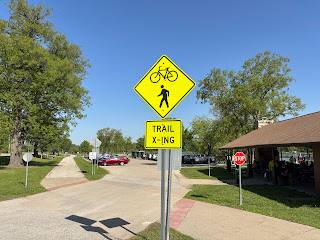 |
| Downtown Cedar Rapids parking map |
The City of Cedar Rapids is surveying residents on the subject of parking in Downtown and surrounding areas (Czech Village, Kingston, New Bohemia). (If you're in CR, and seeing this before Wednesday 6/11, contact me and I'll send you the link.) The survey mostly asks for data about destinations, times, and difficulty parking.
According to my sources, the city is looking at removing meters from downtown, or else adding meters to other areas in the core. If we do remove meters from downtown, however, that will cut the flow of cash to ParkCR, the company to which we foolishly sold the parking concession in 2014, and which is already receiving less income than we had contractually promised. We would have to pay them off somehow.
 |
| Parking instructions from ParkCR, Third Avenue Bridge, Downtown Cedar Rapids |
I'm torn about the parking survey, regardless of how we work things out with ParkCR, because removing meters seems the best thing in the short run for downtown businesses, the city, but more free parking is not in the long-term general interest. We have learned from reading Donald Shoup (he's tough) and Henry Grabar (a much easier go) that free public parking in a high-demand area s a policy mistake, because setting the price at zero makes demand for any product artificially high. Too much demand for parking results in traffic congestion and noise and an unpleasant environment for anyone else in the area. Eventually, it results in pressure on the city to supply more, either through more public lots or parking mandates on developers, which wastes space. High-value land is yielding no revenue, and the empty space it creates between revenue-producing destinations makes the area less walkable and less interesting. Free parking is the enemy of vibe.
Ideally, any city's core would be best advised to develop around non-drivers who are able to walk, bike, wheel, or bus to multiple revenue-producing destinations. I'm fixated on grocery stores and other suppliers of necessities, but Bill Fulton (2025) has observed that:
people who lived near downtowns and liked to walk places tended to drive to the grocery store or the mall, in large part because they want to have a vehicle to haul the stuff home. Since Covid, of course, many of these folks choose to order all kinds of goods online.
Maybe I should stop dreaming about groceries and hardware in the core? Even so, says Fulton,
People who lived [near the downtowns he studied] tended to walk more when they had some place they wanted to walk to. And what they wanted to walk to most often was parks, libraries, cafes, and restaurants.
Our city's core is attractive, but what surrounds it is without form and void.
 |
| Between 5th and 12th Streets, much of the space is dedicated to parking |
Hence, with respect to the very few who ride across the void on our incipient trails system, or utilize our limited public transportation, the only connection to the world outside the void is by private car.
Whether we're talking grocery stores or "parks, libraries, cafes, and restaurants," patrons either come from close by or from far away. If they come from far away. Here's the paradox: The more parking our city provides, the less room there is for the places people want to go. Yet sincerely trying to build a walkable core by putting a price on parking is a risky game, maybe as likely to take businesses off the streets as to put people onto the streets and into destinations. "We don't want parking meters in NewBo," says City Council member Ann Poe.
 |
| Block-long free parking in Czech Village does fill up on weekends |
If you're reading this critically, you'll notice my argument is missing data. I've got none. What I'm also missing is a sense of what the city's vision is. A decade ago, Cedar Rapids seemed motivated to become an active town, bringing in the Blue Zones folks and building separated bike lanes. I really couldn't say what the city's vision is now, other than some vague notion of "success" based in attracting shoppers.
So, what's an urbanist supposed to write in the comments section of the survey? The market price for parking in the core area outside of downtown is probably zero, because there's so much of it. Maybe the best approach is to attend to the needs of core constituents now, even if that means (sob!) more subsidies for car parking and (double sob!) paying off ParkCR with money that would have been better spent elsewhere. Shoup argues for charging market prices for parking, with money devoted to improving the district where it's spent. That alone keeps the path open to a more vibey, financially resilient, walkable future.
 |
| If we've learned anything positive from the DOGE derecho, it's that the national government is no longer a reliable funder of expensive stuff |
P.S. I wonder how many people who resent food assistance or affirmative action as "government handouts" not only allow an exception for parking, but expect that parking should be free?
SEE ALSO: "I Wish This Parking Was...," 27 November 2020















